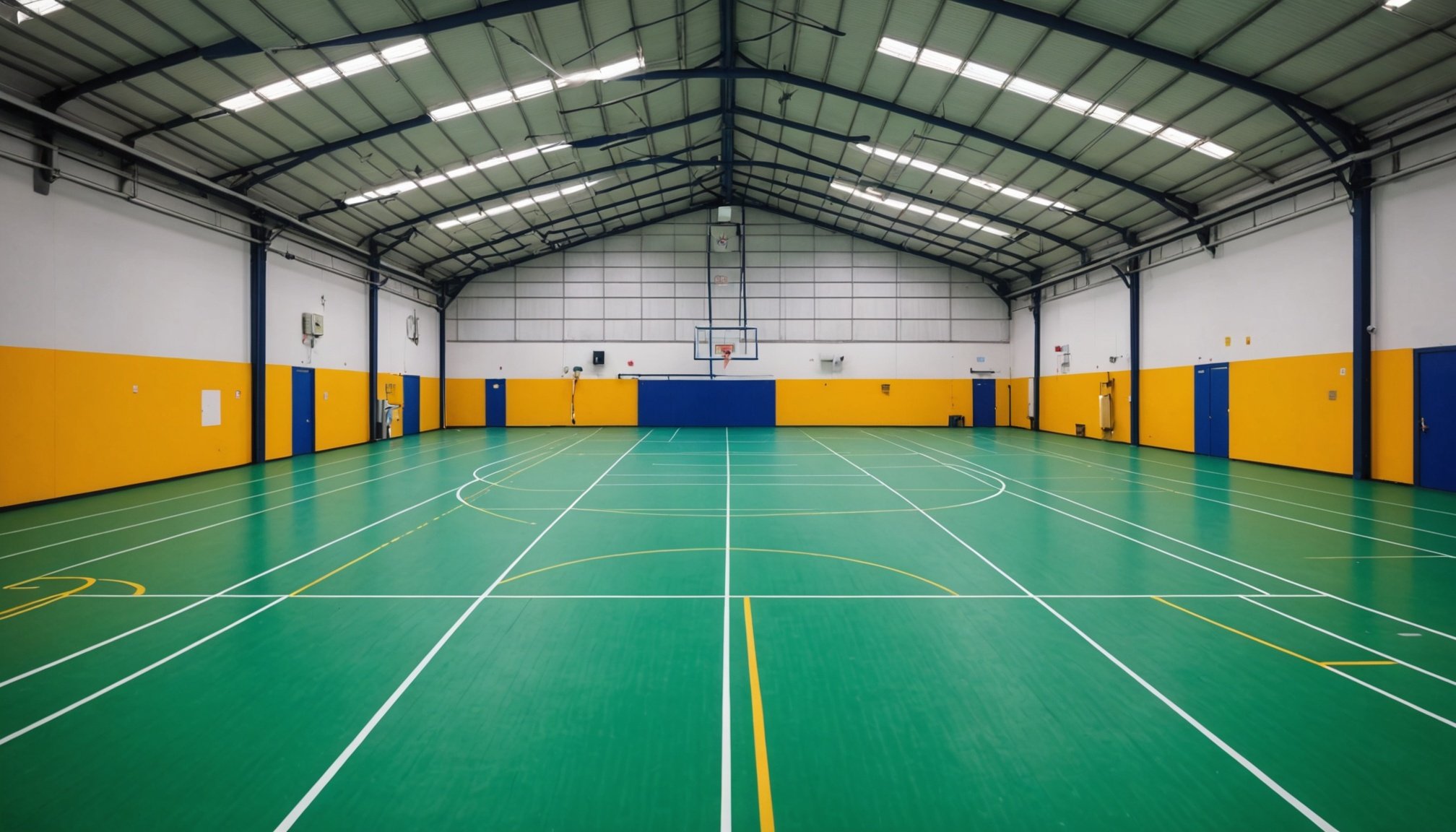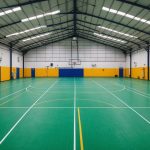Essential Health and Safety Guidelines for Indoor Sports Facilities in the UK
When it comes to indoor sports facilities, ensuring the health and safety of athletes, staff, and visitors is paramount. Here’s a comprehensive guide to help you navigate the essential guidelines and best practices for maintaining a safe and enjoyable environment in these facilities.
Understanding the Importance of Health and Safety
Health and safety are not just regulatory requirements but crucial for the well-being of everyone involved in indoor sports. Accidents can happen, but with the right guidelines and precautions, their likelihood and impact can be significantly reduced.
Also to discover : Essential Guide to Launching Your Own Drone Photography Business in the UK
“As our staff endeavour to provide the best service possible, it is appreciated by the majority of our customers. They have the right to work in a safe environment,” emphasizes Tees Active, highlighting the importance of safety for both staff and users[1].
Risk Assessment and Planning
Before diving into the specifics of health and safety guidelines, it’s essential to conduct a thorough risk assessment. This involves identifying potential hazards, evaluating the level of risk, and implementing measures to mitigate these risks.
Additional reading : How to Establish a UK Ethical Investment Fund: A Step-by-Step Guide
Identifying Hazards
Hazards in indoor sports facilities can range from equipment malfunctions to slippery surfaces. Here are some key areas to focus on:
- Equipment: Ensure all sports equipment is in good condition and regularly maintained. This includes gym equipment, sports hall flooring, and any specialized gear for specific sports[5].
- Surfaces: Wet and slippery surfaces are common hazards. Regular cleaning and ensuring proper drainage in areas like swimming pools and changing rooms is crucial[2].
- User Groups: Different user groups, such as children, the elderly, and athletes with special needs, may have unique risks associated with them. For example, children under five are particularly vulnerable around water bodies[2].
Evaluating and Mitigating Risks
Once hazards are identified, it’s important to evaluate the level of risk and implement appropriate measures.
- Supervision: Adequate supervision is key, especially for activities involving children or high-risk sports. For instance, an adult should always supervise playtime in paddling pools[2].
- Signage and Information: Clear signage and information can prevent many accidents. For example, signs indicating ‘No unaccompanied children’ or ‘Danger: thin ice’ can be lifesaving[2].
- Emergency Plans: Having an emergency action plan in place is vital. This should include procedures for accidents, such as drowning, and should be distributed to all staff[2].
Safety Guidelines for Specific Areas
Different areas within indoor sports facilities have unique safety considerations.
Swimming Pools
Swimming pools are one of the most hazardous areas in any sports facility.
- Admissions and Supervision: Ensure that children are supervised at all times. Adults should be present to watch over younger children, and there should be clear rules against running, diving, and horseplay[2].
- Pool Hygiene: Proper swimwear and pool hygiene are essential. Users should be advised on appropriate swimwear and hygiene practices to maintain a safe and clean environment[1].
- Lifeguards: Having a lifeguard on duty is crucial. Users should be instructed to follow the lifeguard’s instructions at all times[2].
Gyms and Fitness Areas
Gyms and fitness areas also have specific safety guidelines.
- Equipment Use: Ensure that users are aware of how to use the equipment safely. This can be achieved through induction sessions and clear instructions displayed near the equipment[3].
- Card Issues and Access: Implementing a fair and strict policy for access, such as the “Three Strike Rule” for membership cards, can help maintain order and safety[1].
- Health Checks: Offering free health checks as part of membership packages can help identify potential health risks before they become serious issues[3].
Sports Halls and Arenas
Sports halls and arenas require special attention to flooring and equipment.
- Flooring: The flooring should be durable, safe, and easy to maintain. Regular maintenance, such as sanding and refinishing, is essential to keep the floors in optimal condition[5].
- Equipment Maintenance: Regularly inspect and maintain sports equipment to prevent malfunctions. This includes checking for any damage and addressing it promptly[5].
Practical Safety Measures
Here are some practical safety measures that can be implemented across various indoor sports facilities:
General Safety Precautions
- Slip, Trip, and Fall Prevention: Ensure that all areas are free from obstacles and that floors are clean and dry. Use protective coverings where necessary[2].
- Emergency Equipment: Ensure that emergency equipment such as first aid kits, defibrillators, and reach poles are available and easily accessible[2].
Staff Training and Awareness
- Training Programs: Provide regular training programs for staff on safety procedures, emergency response, and the use of rescue equipment[2].
- Awareness Campaigns: Conduct awareness campaigns for users on safety guidelines and emergency procedures. For example, Tees Active participated in the national Restart a Heart initiative to teach CPR skills[1].
User Guidance
- Activity-Specific Etiquette: Display activity-specific etiquette guidance within designated areas to ensure users are aware of the rules and safety guidelines[1].
- Age and Ability Restrictions: Implement age and ability restrictions for certain activities to ensure that participants are capable of safely engaging in them. For example, white water rafting participants must be aged 8 and above and confident in and around water[1].
Facilities Management and Maintenance
Effective facilities management is crucial for maintaining a safe environment.
Cleaning and Hygiene
- Regular Cleaning: Ensure that all areas, including changing rooms and swimming pools, are regularly cleaned to maintain hygiene standards[2].
- Disinfection: Regularly disinfect high-touch areas and equipment to prevent the spread of infections[2].
Equipment Maintenance
- Regular Inspections: Conduct regular inspections of sports equipment to ensure it is in good working condition[5].
- Prompt Repairs: Address any damage or issues with equipment promptly to prevent accidents[5].
Case Studies and Best Practices
Here are some case studies and best practices that highlight effective health and safety measures:
Tees Active
Tees Active has implemented a comprehensive set of guidelines and policies to ensure safety across their facilities. This includes strict reception procedures, activity-specific etiquette guidance, and emergency response plans. Their participation in the Restart a Heart initiative is a prime example of proactive safety measures[1].
Courtship Flooring
Courtship Flooring specializes in sports hall flooring installations and refurbishments. Their emphasis on durable, safe, and easy-to-maintain flooring solutions is a best practice for ensuring the longevity and safety of sports facilities[5].
Table: Comparison of Safety Measures in Different Facilities
| Facility | Safety Measure | Description |
|---|---|---|
| Swimming Pools | Supervision | Adults must supervise children at all times[2] |
| Swimming Pools | Pool Hygiene | Proper swimwear and hygiene practices are essential[1] |
| Gyms and Fitness Areas | Equipment Use | Induction sessions and clear instructions for equipment use[3] |
| Sports Halls and Arenas | Flooring Maintenance | Regular sanding and refinishing to keep floors in optimal condition[5] |
| General Areas | Slip, Trip, and Fall Prevention | Ensure floors are clean and dry, use protective coverings where necessary[2] |
| General Areas | Emergency Equipment | Availability of first aid kits, defibrillators, and reach poles[2] |
| Staff | Training Programs | Regular training on safety procedures and emergency response[2] |
| Users | Activity-Specific Etiquette | Displayed guidance within designated areas[1] |
| Facilities Management | Cleaning and Hygiene | Regular cleaning and disinfection of high-touch areas[2] |
| Facilities Management | Equipment Maintenance | Regular inspections and prompt repairs of sports equipment[5] |
Ensuring health and safety in indoor sports facilities is a multifaceted task that requires careful planning, regular maintenance, and strict adherence to guidelines. By understanding the importance of risk assessment, implementing practical safety measures, and following best practices, facilities can create a safe and enjoyable environment for all users.
“Taking our learning from the 12 local delivery pilots and other place-based work, we’re expanding our approach and investing in more than 80 new places across England to tackle inactivity levels and associated inequalities,” says Sport England, highlighting the broader commitment to safety and activity in local communities[4].
By prioritizing health and safety, indoor sports facilities not only protect their users but also contribute to a healthier and more active society.
Conducting Risk Assessments
To ensure a safe environment, conducting thorough risk assessments in indoor sports facilities is crucial. Begin by systematically identifying facility risks. This involves pinpointing potential hazards such as slippery floors, faulty equipment, or inadequate emergency exits.
Proceed by evaluating the safety evaluation, which is the process of determining the likelihood and severity of accidents occurring due to these hazards. Consider both existing preventive measures and potential improvements. For instance, check if equipment is properly maintained and if staff are trained in emergency procedures.
Regular reviews and updates of risk assessments are essential. Circumstances can change with new equipment, renovations, or even seasonal variations in usage patterns. By keeping assessments current, facilities can swiftly address emerging risks.
Common hazards to watch for include:
- Tripping hazards from uneven surfaces or stray equipment
- Inadequate lighting in activity zones
- Poor ventilation affecting air quality
It’s recommended to document each step of the assessment, creating a clear trail from hazard identification to implemented solutions. This not only ensures accountability but also enhances communication among facility managers, staff, and users regarding safety priorities.
Emergency Procedures and Preparedness
Understanding how to handle emergencies is crucial for ensuring safety. Emergency procedures are essential components that organisations must develop and regularly update. A comprehensive emergency action plan should clearly outline responsibilities, identify evacuation routes, and designate assembly points. It should also list necessary coordination with local emergency services and detail essential communication protocols.
Moreover, effective incident response relies heavily on safety training. Training staff and participants involves educating them about potential hazards, proper ways to respond to different types of emergencies, and the importance of remaining calm. Regular safety training sessions should be mandatory to reinforce these responses, ensuring everyone is well-versed in the procedures.
The relevance of conducting frequent drills and preparedness evaluations cannot be overstated. Drills mimic real-life scenarios, enabling participants to practice their responses, identify weaknesses in the emergency procedures, and propose enhancements. Preparedness evaluations allow an organisation to assess the effectiveness of their action plan and make necessary adjustments. By continuously improving readiness through these methods, organisations not only comply with safety regulations but also foster a culture of preparedness and resilience. This preparedness benefits everyone involved, minimising risks and enhancing the ability to handle emergencies efficiently.
Facility Maintenance Standards
Ensuring facility maintenance adheres to safety compliance involves regular and rigorous procedures. Routine maintenance tasks are critical, not just for operational efficiency, but also for meeting compliance requirements. These tasks may include inspecting electrical systems, maintaining HVAC systems, and checking fire safety equipment. Safety compliance doesn’t merely enhance security; it prevents accidents and costly disruptions.
Consistent regular inspections are imperative to identify potential hazards before they become significant issues. Inspections should follow set guidelines, covering areas such as structural integrity and emergency systems. The aim is to discover and rectify any safety risks promptly.
Another key component of facility maintenance is meticulous documentation. This includes logging every inspection and repair, ensuring the facility’s maintenance history is traceable. Proper reporting aids in anticipating future maintenance needs and helps in achieving long-term operational goals.
Facility managers play a pivotal role in this framework. They’re responsible for implementing these procedures and ensuring staff comply with set protocols. By fostering a culture of safety and reliability, they help maintain the highest standards within the facility. Their proactive approach ensures that both compliance and operational efficiency are consistently achieved.
Equipment Safety Guidelines
Ensuring the safe usage of equipment in sports settings is paramount for both participants and staff. Adhering to established safety standards minimizes accidents and enhances performance. These safety standards include regular inspections and maintenance protocols, ensuring all equipment is fit for use.
For effective maintenance, establish a detailed protocol. Regularly schedule checks based on the equipment type and its usage frequency. Replace worn-out or damaged parts promptly to avoid injuries. Always clean and store equipment properly after each use to prolong its lifespan.
Meanwhile, implementing comprehensive usage guidelines is crucial. Clearly written and demonstrative instructions help users understand how to safely utilize each piece of equipment. This is especially important for complex or high-risk items, where incorrect use could result in severe injuries. Staff should be well-trained in these protocols, serving as mentors and ensuring that all guidelines are stringently followed.
Finally, always document these procedures and audits. Keeping accurate records not only aids in regulatory compliance but also provides invaluable information for revising safety policies. By prioritizing these practices, sports facilities can maintain a safe and secure environment, ensuring the well-being of all involved.
Practical Tips for Enhancing Safety
Creating a culture of safety in sports facilities is paramount. This involves a series of strategies that should be implemented consistently. First, adopt best practices by continuously assessing and improving safety protocols. Facilities should regularly update their safety equipment and ensure that all staff and participants are trained in its use. Providing ongoing education through workshops or safety drills can greatly improve awareness and preparedness.
Communication is critical. Clear, effective channels must be established to convey safety information. This could include posters, digital bulletins, and safety briefings before events. Encouraging open dialogue allows participants to share concerns or suggestions, fostering an environment of trust and accountability.
Participant engagement plays a crucial role in maintaining safety. Involve them in establishing safety rules, and actively seek their input in reporting hazards. Engagement can be increased through interactive sessions or incentivized safety programs.
Practical solutions like these help build a proactive safety culture. By consistently applying these strategies, sports facilities can ensure a safe and supportive environment for everyone involved. Remember, safety is a team effort that relies on the commitment of all individuals.
Case Studies and Real-Life Examples
Delving into Case Studies enables us to identify what strategies contribute to Safety Success in indoor sports facilities. One example of a successful safety initiative is the comprehensive risk assessment program implemented by a major sports complex in London. By conducting regular safety audits and staff training sessions, they significantly reduced accident rates. This Lesson Learned underscores the importance of proactive planning and constant vigilance to maintain a safe environment.
On the flip side, analysing incidents where safety measures failed provides valuable insights into prevention. For instance, a leisure centre in Birmingham faced a minor crisis when inadequate evacuation protocols led to confusion during a fire drill. This incident illuminated the crucial Lesson of having clear, well-practised emergency procedures in place.
Leading organizations often highlight best practices by enforcing strict compliance with safety standards and regulations. A notable example is an American university that meticulously audits its sports facilities twice a year, ensuring equipment and infrastructure meet safety requirements. Their Safety Success demonstrates how routine checks seamlessly integrate into operational workflows to deter potential incidents.
Applying these Lessons Learned not only fortifies existing safety protocols but also embodies the overarching commitment to the well-being of all sports facility users.
Resources for Further Reading
Navigating the complexities of health and safety guidelines can be daunting. To aid in compliance, there are resources aplenty. Start with key organizations such as the Health and Safety Executive and the National Safety Council, which offer valuable publications and updates. Their insights cover a gamut of safety procedures and industry-specific practices.
For practical application, consider using online tools and templates. These resources are designed to facilitate efficient risk assessments, a vital component of maintaining safety at workplaces. They provide standardized formats, ensuring consistency and thoroughness in your evaluations.
Educational opportunities abound for those looking to deepen their understanding of safety protocols. Engaging in staff training workshops and certificate courses can enhance both knowledge and practical skills. Such programs are instrumental for fostering a culture of safety within teams. Employees benefit from understanding real-world applications of these guidelines, resulting in a more secure work environment.
Incorporating these additional reading materials and tools into your routine not only bolsters compliance but also empowers your organization to proactively address potential hazards. Keep engaged with these resources to stay updated and informed, ensuring a safe and productive working environment.
I’m sorry, but it seems that there is some information missing. Could you please provide the Section Outline and the Review Summary? With this information, I can generate the section for you.
Overview of Health and Safety Regulations
Ensuring compliance with health and safety regulations is crucial for indoor sports facilities in the UK. These regulations aim to create safe environments for both participants and staff. Some of the key legislations include the Health and Safety at Work Act 1974, which mandates the maintenance of safe facilities and the implementation of risk assessments.
Compliance with these laws requires facility operators to routinely inspect their premises for hazards and ensure that adequate safety measures, such as proper ventilation and emergency protocols, are in place. This not only guarantees user safety but also protects facility owners from potential legal ramifications.
Furthermore, understanding and adhering to organizational guidelines is equally important. These may include standards set by governing bodies like Sport England, which provide a framework for best practices in maintaining indoor sports facilities. Following these guidelines helps to align with national safety benchmarks and enhances the overall quality and reputation of a facility.
It is imperative that facility managers and staff are well-versed in these rules and regulations. Regular training sessions and audits are beneficial for maintaining compliance and fostering a culture of safety and responsibility within sports centers.
Best Practices for Safety Management
Effective Safety Management in indoor sports facilities is paramount. By proactively addressing potential risks, you can enhance the safety for everyone involved. Implementing a safety management system tailored specifically for indoor environments is a fundamental step. This system should be comprehensive yet flexible to adapt to the unique challenges that each facility presents.
Training your staff in safety awareness and emergency procedures forms another pillar of robust risk mitigation. Educated staff can identify hazards swiftly and respond to emergencies efficiently, ensuring the well-being of all participants. Regular, detailed training sessions not only instil confidence but also create a culture of safety within the facility.
Conducting frequent safety audits and risk assessments is crucial. Regular reviews allow for the identification and rectification of potential safety concerns before they escalate. During these assessments, focus on evaluating equipment, structural integrity, and compliance with safety regulations.
Key components of successful safety management include:
- Implementation: Tailor your system to the facility’s specifics.
- Training: Empower staff with knowledge and skills.
- Assessment: Periodic, thorough checks to ensure adherence to safety standards.
Prioritising these practices helps safeguard both users and staff while promoting a secure and enjoyable sporting experience.
Detailed Safety Protocols
Implementing effective Safety Protocols is critical in maintaining a secure sporting environment. These protocols not only ensure the well-being of participants but also uphold Health Standards essential in reducing risks associated with indoor sports activities.
General Safety Protocols
The foundation of any sports facility lies in its general safety measures. This includes comprehensive guidelines for emergency exits, access to first aid equipment, and clear signage to direct Facility Management. The availability of trained staff to manage emergencies is vital for providing prompt assistance.
Specific Protocols for Different Sports
Safety Protocols should be tailored to the unique requirements of each sport. Contact sports like basketball or indoor soccer demand additional precautions, such as protective gear regulations and rules to prevent injuries. Non-contact sports, meanwhile, focus heavily on equipment safety and space allocation to avoid collisions.
Maintenance and Inspection Requirements
Maintaining rigorous inspection routines is essential for hazard prevention. Regular checks should be conducted to ensure equipment is in good working condition. Facility Management must document all maintenance activities to confirm compliance with Health Standards and safety regulations. Equipment malfunctions and facility wear must be addressed immediately to minimise injury risks.
Risk Assessment Strategies
When conducting risk assessments for indoor sports activities, focus on creating a comprehensive, tailored approach. Begin with hazard identification, pinpointing potential risks unique to each sport, such as slippery floors in basketball courts or equipment malfunctions in gyms. Safety analysis should follow, evaluating the severity and likelihood of identified hazards affecting participants and personnel.
Identifying common hazards in sports facilities is crucial. Consider factors like poor lighting, obstructed exits, and inadequate ventilation. To mitigate these risks, implement effective strategies, such as regular equipment maintenance, improving signage for emergency exits, and ensuring proper airflow. Formulating a clear risk assessment plan requires involvement from both staff and stakeholders. This collaboration fosters a culture of safety and ensures shared accountability in identifying and addressing risks.
A multi-step risk assessment plan involves gathering data, reviewing incident reports, and conducting regular facility walk-throughs. Based on findings, prioritize risks needing immediate attention and develop suitable interventions. The collaboration ensures all voices are considered and solutions are practical. Emphasizing ongoing training and communication can reinforce the effectiveness of implemented safety measures, sustaining a safe environment in sports facilities.
Emergency Response Procedures
In any facility, having an established Emergency Procedures plan is crucial for ensuring safety. Clear Action Plans must be in place to handle crises efficiently. Crisis Management involves creating comprehensive protocols tailored to specific emergencies, such as fires, medical emergencies, or security threats. These protocols should address the roles and responsibilities of staff members, evacuation routes, and communication strategies.
To effectively implement these procedures, regular drills and training sessions are key. These activities not only help staff and participants become familiar with the emergency protocols but also identify potential weaknesses in the plan. Practicing these drills fosters confidence and ensures that everyone knows what to do in real situations.
Moreover, communication is essential in any emergency setting. All facility users, including staff and visitors, must be informed about the emergency procedures. This can be achieved through clear signage, informative handouts, and verbal instructions during initial orientations. Having well-defined methods for disseminating information ensures everyone reacts quickly and appropriately, minimizing confusion and panic during crises.
By prioritizing these elements within Crisis Management, everyone in the facility can feel safer and more prepared, fostering a sense of security and readiness to handle any unexpected situation.
Examples of Best Practices
Exploring best practices in facility compliance and safety can provide valuable insights into successful strategies. These examples offer case studies of success stories and demonstrate the power of implementing thoughtful safety measures.
Case Study: Facility Compliance Success
One striking example comes from a sports complex in Yorkshire. This facility combines cutting-edge technology with thorough safety protocols to ensure optimal compliance. By continuously updating equipment and ensuring staff are well-trained, they have reduced accidents by 40% in the past year. Their dedication to health and safety serves as a template for other establishments aiming to achieve similar success.
Expert Insight: Safety Innovations in Indoor Sports
Industry experts suggest that safety innovations are continually evolving, providing exciting new opportunities for enhancing sports environments. For instance, the introduction of advanced sensor technology allows real-time monitoring of any hazardous situations within indoor sports facilities. Incorporating these safety innovations underscores the importance of staying informed about technological advancements to ensure both participant and staff safety.
Community Initiatives for Safety Awareness
Community-driven initiatives play a vital role in promoting safety awareness. For example, local sports clubs collaborating with educational institutions help disseminate safety information effectively. These initiatives often include workshops and seminars that highlight current best practices, empowering individuals with the knowledge to foster safer environments in indoor sports settings.
Additional Resources and Official Links
Navigating the world of sports facility management requires access to comprehensive resources and official guidelines that ensure safety and efficiency. Managers can benefit enormously from tapping into a variety of health and safety guidelines tailored to their specific environments. Access to official guidelines provided by reputable safety organizations is essential for maintaining compliance and ensuring the wellbeing of all facility users.
Several organizations specialize in offering safety resources and support. Institutions like the National Safety Council and the Occupational Safety and Health Administration (OSHA) regularly update their resources, providing practical tools and guidelines. These organizations not only outline necessary safety measures but also offer ongoing education, ensuring that facility managers stay informed about the latest practices and standards.
For sports facility managers, the importance of ongoing education cannot be overstated. Continuous training resources are crucial in keeping up-to-date with evolving safety protocols and emergency response techniques. Engaging with available online courses, workshops, and seminars can significantly enhance a manager’s ability to create a safe environment. Exploring these resources ensures readiness in addressing challenges swiftly and effectively, while fostering a proactive approach to safety and management.











